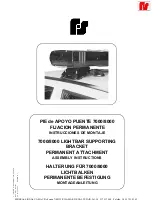
Cargo area
Vehicle features and
options
This chapter describes all standard, country-spe‐
cific and optional features offered with the series.
It also describes features and functions that are
not necessarily available in your vehicle, e.g., due
to the selected options or country versions. This
also applies to safety-related functions and sys‐
tems. When using these functions and systems,
the applicable laws and regulations must be ob‐
served.
Loading
Safety information
Warning
High gross weight can overheat the tires, dam‐
age them internally and cause a sudden drop in
tire inflation pressure. Driving characteristics
may be negatively impacted, reducing lane sta‐
bility, lengthening the braking distances and
changing the steering response. There is a risk
of accident. Pay attention to the permitted load
capacity of the tires and never exceed the per‐
mitted gross weight.
Warning
Loose objects or devices with a cable connec‐
tion to the vehicle, for instance mobile phones,
can be thrown about the car's interior while
driving, for instance in the event of an accident,
braking or evasive maneuver. There is a risk of
injury. Secure loose objects or devices with a
cable connection to the vehicle in the car's in‐
terior.
Warning
Improperly stowed objects can shift and be
thrown into the car's interior, for instance in the
event of an accident or during braking and eva‐
sive maneuver. Vehicle occupants can be hit
and injured. There is a risk of injury. Stow and
secure objects and cargo properly.
NOTICE
Fluids in the cargo area can cause damage.
There is a risk of damage to property. Make
sure that no fluids leak in the cargo area.
Steps for Determining Correct
Load Limit
1.
Locate the statement “The combined weight
of occupants and cargo should never exceed
XXX kg or XXX lbs” on your vehicle’s placard.
2.
Determine the combined weight of the driver
and passengers that will be riding in your ve‐
hicle.
3.
Subtract the combined weight of the driver
and passengers from XXX kg or XXX lbs
4.
The resulting figure equals the available
amount of cargo and luggage load capacity.
For example, if the “XXX” amount equals
1,400 lbs and there will be five 150 lbs pas‐
sengers in your vehicle, the amount of availa‐
ble cargo and luggage load capacity is
650 lbs (1,400 - 750 (5 x 150) = 650 lbs)
5.
Determine the combined weight of luggage
and cargo being loaded on the vehicle. That
weight may not safely exceed the available
cargo and luggage load capacity calculated in
Step 4.
6.
If your vehicle will be towing a trailer, load
from your trailer will be transferred to your ve‐
Seite 300
CONTROLS
Cargo area
300
Online Edition for Part no. 01405A11338 - VI/20
















































